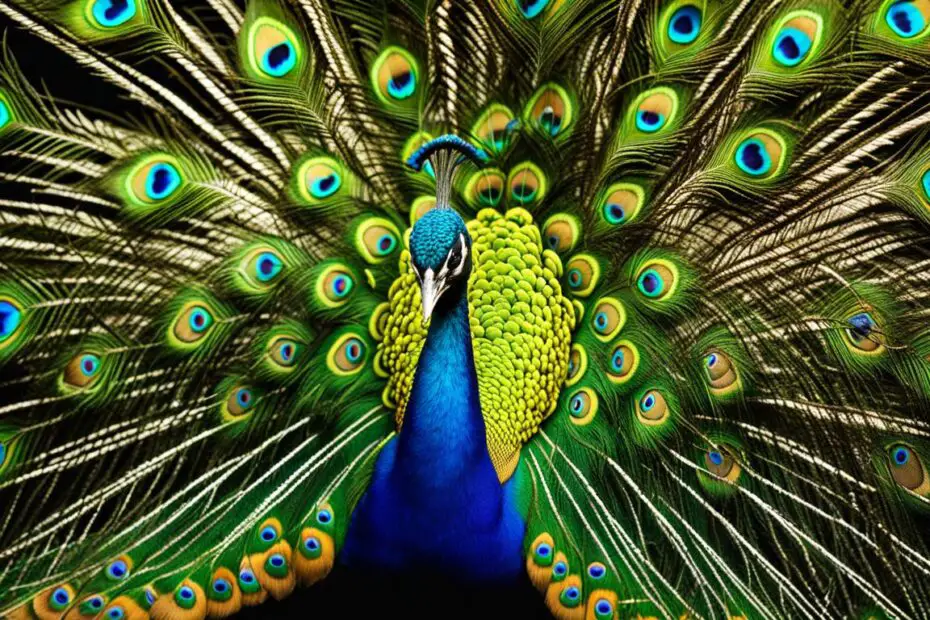Peacocks are known for their stunning and vibrant colors, making them one of the most beautiful birds in nature. The colors of peacocks can vary greatly, with shades ranging from vibrant blues and greens to rare colors like white, red, purple, and pink. These colorful feathers are found in both male and female peacocks, adding to the diversity of their appearance. Peacock colors are not only a result of pigmentation but also the structure of their feathers, which create iridescence and reflect light in unique ways.
Key Takeaways:
- Peacocks exhibit a wide range of colors, including vibrant blues, greens, and rare shades like white, red, purple, and pink.
- The colors of peacock feathers are a result of both pigmentation and the unique structure of their feathers.
- Peacock colors can appear different depending on the lighting conditions and viewing angle.
- Male and female peafowls have distinct coloration, with males displaying vibrant colors to attract mates.
- The optical physics behind peacock colors has inspired advancements in materials and technologies.
The Common Peacock Colors
The vibrant colors of peacocks make them a sight to behold. While peacocks come in a variety of stunning hues, the most commonly seen colors are blue and green. Blue peacocks, also known as Indian peacocks, have bold blue coloration on their heads and necks, creating a striking contrast with their iridescent green feathers. Green peacocks, on the other hand, exhibit a rich green color on their heads and necks, complementing their shimmering blue and green plumage.
These common peacock colors are primarily determined by the pigmentation in their feathers. The intricate arrangement of pigments creates the vivid hues that we admire. Blue peacocks possess a unique pigment called melanin in their feathers, which absorbs most of the light and reflects the blue wavelengths, resulting in their stunning blue coloration. Green peacocks, on the other hand, exhibit a combination of yellow pigments with the structural arrangement of their feathers, producing the vibrant green hue that adorns their plumage.
The beauty of these common peacock colors is further enhanced by the structural arrangement of their feathers. Microscopic structures, such as ridges and platelets, interact with light, scattering and reflecting it in ways that create a captivating iridescent effect. This interplay of pigmentation and structural arrangement gives peacocks their dazzling and awe-inspiring colors, making them one of nature’s most breathtaking creations.
Table: Comparison of Blue and Green Peacock Colors
| Blue Peacock | Green Peacock | |
|---|---|---|
| Main Color | Blue | Green |
| Secondary Color | Green | Blue |
| Pigmentation | Melanin | Yellow pigments |
| Light Interaction | Reflects blue wavelengths | Combination of yellow pigments and structural arrangement |
| Appearance | Bold and vibrant | Rich and shimmering |
Rare Peacock Colors
While blue and green are the most common peacock colors, there are several rare colors that can be found in certain peacock species. One of the rarest colors is white, which is often associated with albino peafowl. Red, purple, and pink are also considered rare colors and are the result of genetic mutations or unique variations in pigmentation. It is important to note that these rare colors are not as commonly observed in peacocks compared to the more common blue and green colors.
White peacocks, also known as leucistic peafowl, are a rarity in the peacock world. Their feathers lack the pigmentation that gives most peacocks their vibrant colors, resulting in a stunning white appearance. Their striking beauty makes them highly sought after and admired by bird enthusiasts and collectors.
“White peacocks are truly mesmerizing creatures. Their pure white feathers are a symbol of grace and elegance. It’s a privilege to witness such a rare and majestic sight in nature,” says renowned ornithologist Dr. Elizabeth Davis.
Red, purple, and pink peacocks are also incredibly rare. These colors are usually the result of genetic mutations that affect the production of pigments in the feathers. The intense red hues, deep purples, and delicate pinks make these peacocks stand out in any flock. Their unique colors are a testament to the diversity and wonder of nature.
The Rarity of Rare Peacock Colors
The rarity of these colors makes them even more prized and coveted. Their scarcity in the wild and the difficulty in breeding peacocks with these rare colorations contribute to their exclusivity. Peacock enthusiasts and collectors value these rare colors for their uniqueness and the challenge they pose in acquisition and breeding.
| Color | Characteristics |
|---|---|
| White | Feathers lack pigmentation, resulting in a pure white appearance |
| Red | Intense red coloration, caused by genetic mutations affecting pigmentation |
| Purple | Deep purple hues, a result of unique variations in pigmentation |
| Pink | Delicate pink shades, caused by genetic mutations altering pigment production |
These rare peacock colors serve as a reminder of the incredible diversity and beauty found in nature. They inspire awe and admiration, showcasing the wonders that can arise from genetic variations and mutations. The scarcity of these colors only adds to their allure, making them highly cherished by peacock enthusiasts and nature lovers worldwide.
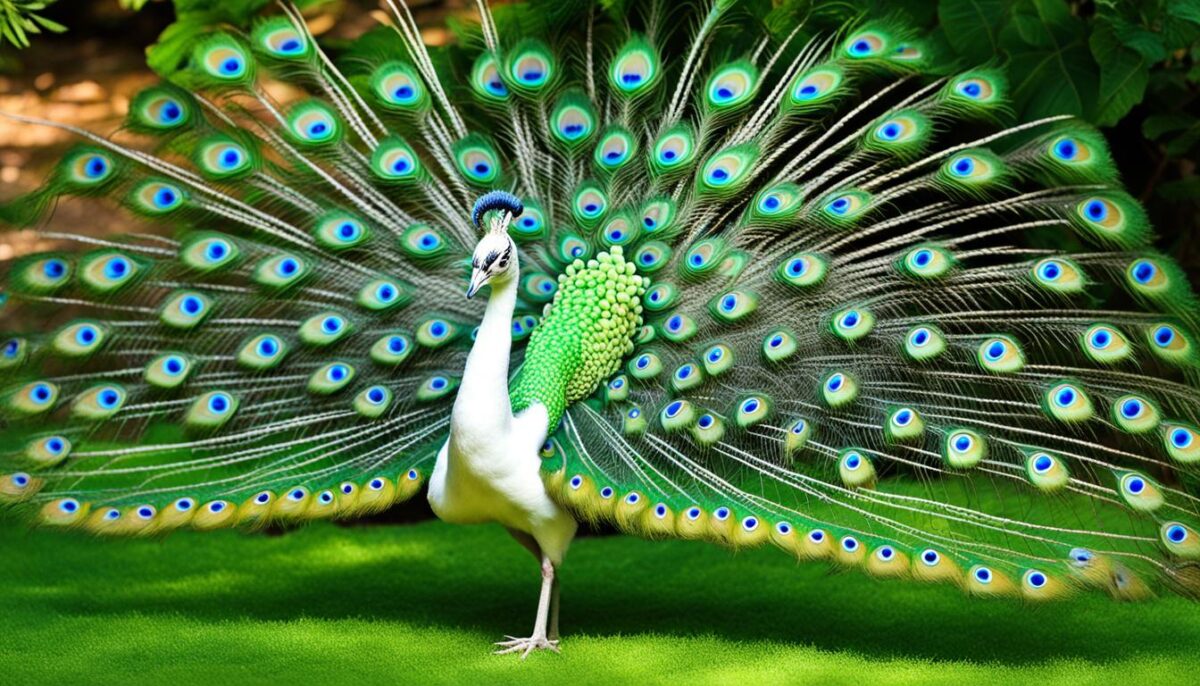
How Peacock Colors Are Created
Peacock colors are a mesmerizing display of nature’s artistry, created through a combination of pigmentation and the structural arrangement of the feathers. The feathers of peacocks have intricate microscopic structures that interact with light in unique ways, resulting in the vibrant and iridescent colors that captivate our eyes.
The structure of peacock feathers plays a crucial role in color production. These feathers contain ridges, rods, and platelets that scatter and reflect light, creating a dazzling array of colors. The arrangement of these structures determines how light is dispersed, resulting in the various shades and patterns seen in peacock feathers.
The pigmentation in peacock feathers is another factor that contributes to their stunning colors. Melanin and other pigments add depth and richness to the overall coloration, enhancing the visual impact of the feathers. It is this combination of structural and pigmentation factors that gives peacocks their unique and enchanting color palette.
Understanding how peacock colors are created not only allows us to appreciate the beauty of these magnificent creatures, but it also inspires advancements in various fields. Scientists and engineers are studying the optical properties of peacock feathers to develop new materials and technologies that can mimic their iridescent colors and light manipulation abilities. By unraveling the secrets of peacock coloration, we gain insights into the intricate workings of nature’s palette.
The Role of Lighting in Peacock Colors
When it comes to the stunning colors of peacock feathers, the role of lighting cannot be overlooked. The way peacock feather colors appear to the human eye is influenced by the interaction of light with the unique structures and pigmentation of the feathers. The angle at which light hits the feathers and the angle at which it is reflected back determine how the colors are perceived.
Peacock feathers have microscopic structures that scatter and reflect light in specific ways, creating the iridescent and vibrant colors that we admire. These structures, such as ridges, rods, and platelets, interact with light differently depending on the angle of incidence. As a result, the colors of peacock feathers can seem to change when viewed from different angles or under different lighting conditions.
For example, a peacock feather that appears green when viewed head-on may appear blue when viewed from the side. This phenomenon is known as angle-dependent coloration and adds to the dynamic nature of peacock colors. The way light interacts with peacock feathers creates a visually captivating display that enhances the beauty of these magnificent birds.
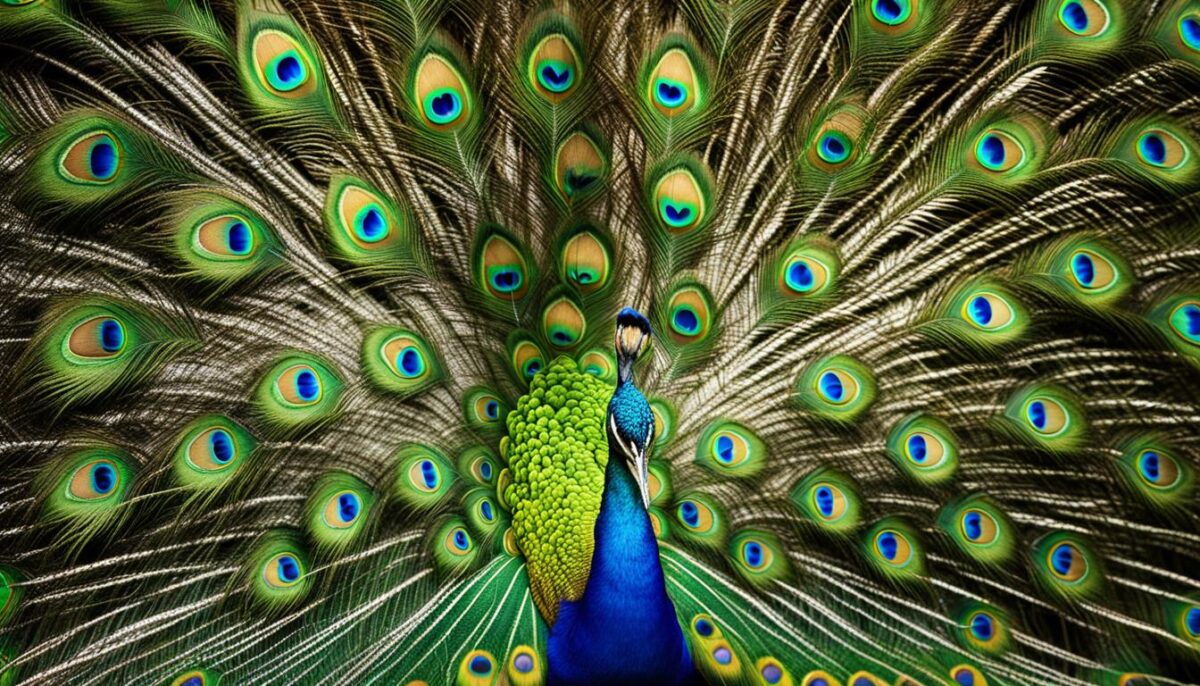
| Lighting Condition | Color Perception |
|---|---|
| Natural sunlight | Full spectrum of vibrant colors |
| Direct artificial light | Enhanced color saturation |
| Diffused light | Softened color tones |
The interaction of light with peacock feathers has not only captivated human observers but has also inspired scientific research. By studying the optical properties of peacock colors, researchers can gain insights into light manipulation and develop technologies that mimic the vibrant and iridescent colors found in nature. The unique interplay between light and peacock feathers continues to be an area of fascination and exploration, leading to new discoveries and advancements in the field of optics.
In summary, the colors of peacock feathers are not only determined by their pigmentation and structural arrangement but are also influenced by the angle of light reflection. The way light interacts with the unique structures of peacock feathers creates the mesmerizing colors that we admire. Understanding the role of lighting in peacock colors allows us to appreciate the beauty of these magnificent birds and inspires further research into the field of optical physics.
References:
- Ghiradella, H. (1984). Structure and development of iridescent scales on the ventral wing surface of Morpho butterflies (Lepidoptera: Nymphalidae). Journal of Research on the Lepidoptera, 23(4), 225-238.
- Vukusic, P., & Sambles, J. R. (2003). Photonic structures in biology. Nature, 424(6950), 852-855.
- Vignolini, S., Moyroud, E., Glover, B. J., & Steiner, U. (2012). Analysing photonic structures in plants. Journal of Optics, 14(2), 024001.
Do Peacocks Change Their Colors?
In contrast to the ability of chameleons to change colors, peacocks do not actively change their colors. The stunning colors of peacock feathers are determined by their genetics and the way their feathers are built, rather than through physiological changes.
Peacocks grow their feathers gradually over time, with the vibrant and colorful feathers fully developing when they reach maturity, which is typically around 6 years old. Male and female peafowls display distinct coloration, with male peacocks showcasing the iconic vibrant blue and green feathers, while female peahens have duller brown feathers.
This difference in coloration between males and females serves an important purpose in attracting potential mates. The vibrant colors of male peacocks play a crucial role in courtship displays, as they use their colorful feathers to attract the attention of female peahens. The more dazzling the colors, the more likely it is for the male peacock to be chosen as a mate.
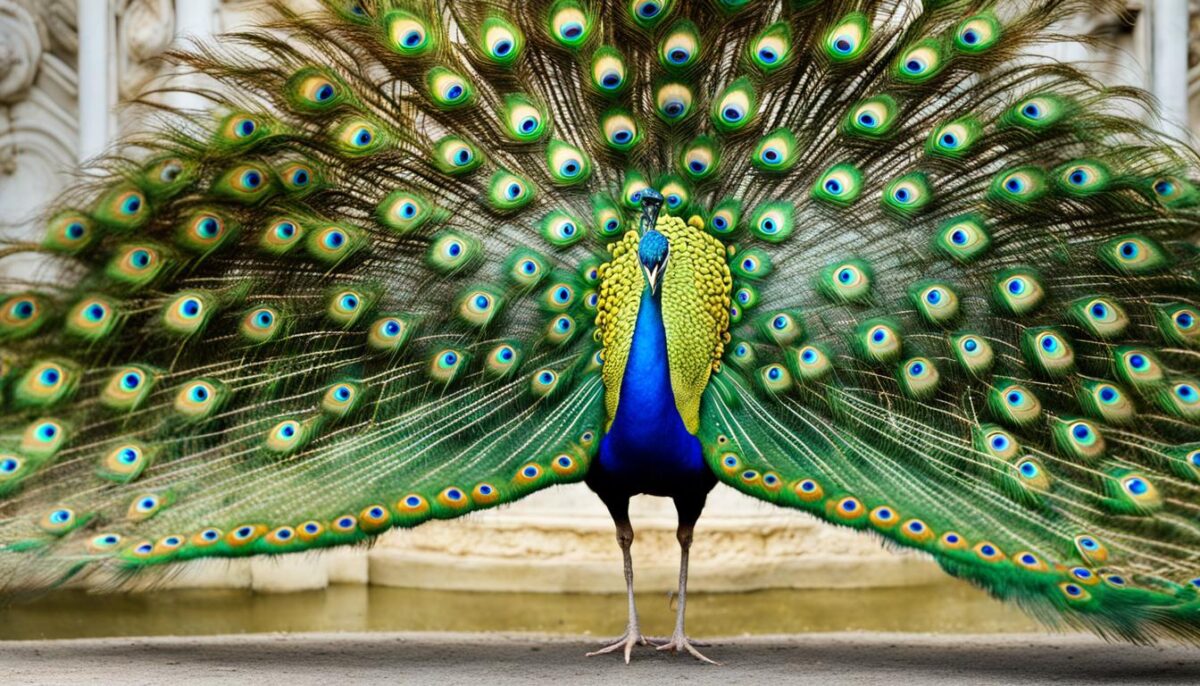
Peacock Egg Color
Peacock eggs display a range of colors, primarily white or light brown. The color of the eggs is determined by the genetics of the female peahen. When the chicks hatch, they exhibit a vibrant yellow coloration. This yellow plumage serves as a camouflage mechanism, helping them blend in with their surroundings and remain hidden from predators.
As the chicks mature, the male peacocks develop their signature vibrant and iridescent feathers, while the female peahens retain their duller coloring. It takes approximately 2 years for male peacocks to reach sexual maturity, at which point their colors become fully developed. Female peahens, on the other hand, reach sexual maturity around 3 years of age. The difference in coloration between males and females plays a critical role in attracting potential mates.
| Egg Color | Chick Coloration | Sexual Maturity |
|---|---|---|
| White or light brown | Vibrant yellow | Male: 2 years old Female: 3 years old |
Male peacocks are not monogamous and can mate with multiple females, leading to the production of 4 to 7 chicks per year.
The color development in peacocks, from the eggs to maturity, is a fascinating process that showcases the unique and intricate nature of these birds. The range of colors observed in peacocks adds to the overall beauty and diversity found in nature’s palette.
Peacock Species
Peacocks are a diverse group of birds, and there are three main species: the Indian peacock, the Congo peacock, and the green peacock. Each species has its own unique characteristics and can be identified by its distinct coloration and feather patterns.
Indian Peacock
The Indian peacock, also known as the blue peacock, is the most common species of peacock. It is native to India and Sri Lanka and is known for its vibrant blue and green feathers. The male Indian peacock is known for its extravagant display of colorful feathers during courtship, while the female, known as a peahen, has more subdued brown feathers.
Congo Peacock
The Congo peacock is a lesser-known species found in the African rainforest, primarily in the Democratic Republic of Congo. It is smaller in size compared to the Indian peacock and has a unique coloration. The male Congo peacock has bluish-gray feathers with a metallic sheen, while the female has a more brownish-gray coloration. The Congo peacock is not as well-studied as the Indian peacock, but its striking appearance makes it a fascinating species.
Green Peacock
The green peacock, as the name suggests, is characterized by its rich green feathers. It is found in Southeast Asia, primarily in countries like Myanmar, Thailand, and Java. The male green peacock has an impressive display of long, iridescent green feathers, while the female has shorter and less vibrant feathers. The green peacock is less commonly seen in zoos and exhibits compared to the Indian peacock.
| Species | Native Region | Male Coloration | Female Coloration |
|---|---|---|---|
| Indian Peacock | India and Sri Lanka | Blue and green feathers | Brown feathers |
| Congo Peacock | African rainforest | Bluish-gray feathers with a metallic sheen | Brownish-gray feathers |
| Green Peacock | Southeast Asia | Iridescent green feathers | Shorter and less vibrant feathers |
These three species of peacocks showcase the incredible beauty and diversity of these magnificent birds. Each species has its own unique charm and characteristics, making them a true marvel of nature.
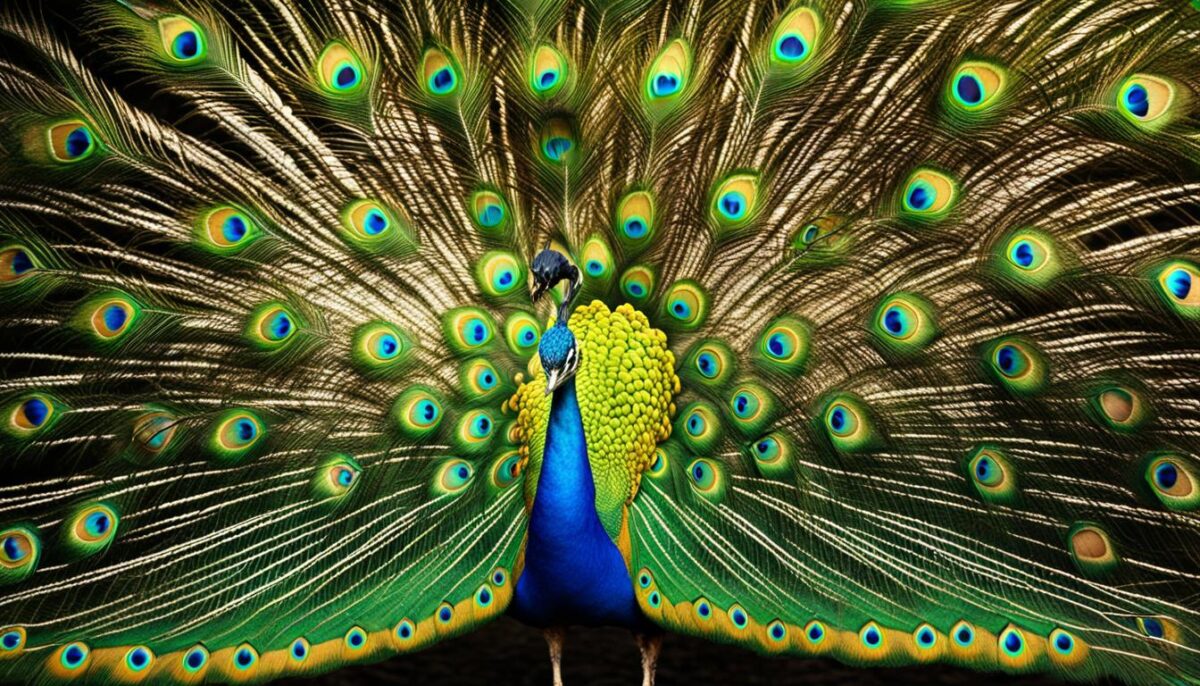
The Optical Physics of Peacock Colors
The stunning and vibrant colors of peacock feathers are not only a result of pigmentation but also the optical physics behind their unique structure. The microscopic structures present in the feathers, such as ridges, rods, and platelets, play a crucial role in how light interacts with the feathers, resulting in the dazzling display of colors. These structures scatter and reflect light in specific ways, giving rise to the iridescent and vibrant hues observed in peacock feathers.
Light scattering and diffraction are key mechanisms contributing to the creation of peacock colors. When light hits the microscopic structures on the feathers, it scatters and undergoes diffraction, leading to the separation of various wavelengths. This phenomenon enhances the reflectivity of specific wavelengths, allowing peacock feathers to exhibit a wide range of colors. The precise arrangement and composition of these nanostructures further contribute to the brilliance and richness of peacock colors.
Peacock feathers showcase the beauty of light manipulation at the nanoscale, where the arrangement of structures creates a visually striking effect. The interplay between light scattering, diffraction, and nanostructures results in the extraordinary colors that have captivated humans for centuries.
Reflectivity is another important factor determining the colors of peacock feathers. The nanostructures in the feathers are designed to reflect and amplify certain wavelengths of light, while absorbing others. This selective reflectivity is what gives peacock feathers their unique and vibrant colors, as different wavelengths combine and interact to produce specific hues. The intricate optical physics of peacock colors continues to inspire scientists and researchers in the development of artificial materials and optical technologies that mimic this natural phenomenon.
| Light Interaction Mechanisms | Key Features |
|---|---|
| Scattering | Microscopic structures scatter light, separating wavelengths and enhancing color visibility. |
| Diffraction | Light undergoes diffraction, further contributing to the separation of wavelengths and color variety. |
| Nanostructures | Precisely arranged nanostructures amplify reflectivity, resulting in brilliant and iridescent colors. |
| Reflectivity | Selective reflectivity of certain wavelengths creates the unique and vibrant hues of peacock feathers. |
The study of the optical physics behind peacock colors not only enhances our understanding of nature’s brilliance but also opens doors to advancements in various industries. By harnessing the principles of light scattering, diffraction, and nanostructures, researchers can develop innovative materials and technologies that manipulate and control light for applications such as display technologies, sensors, and advanced optical devices.
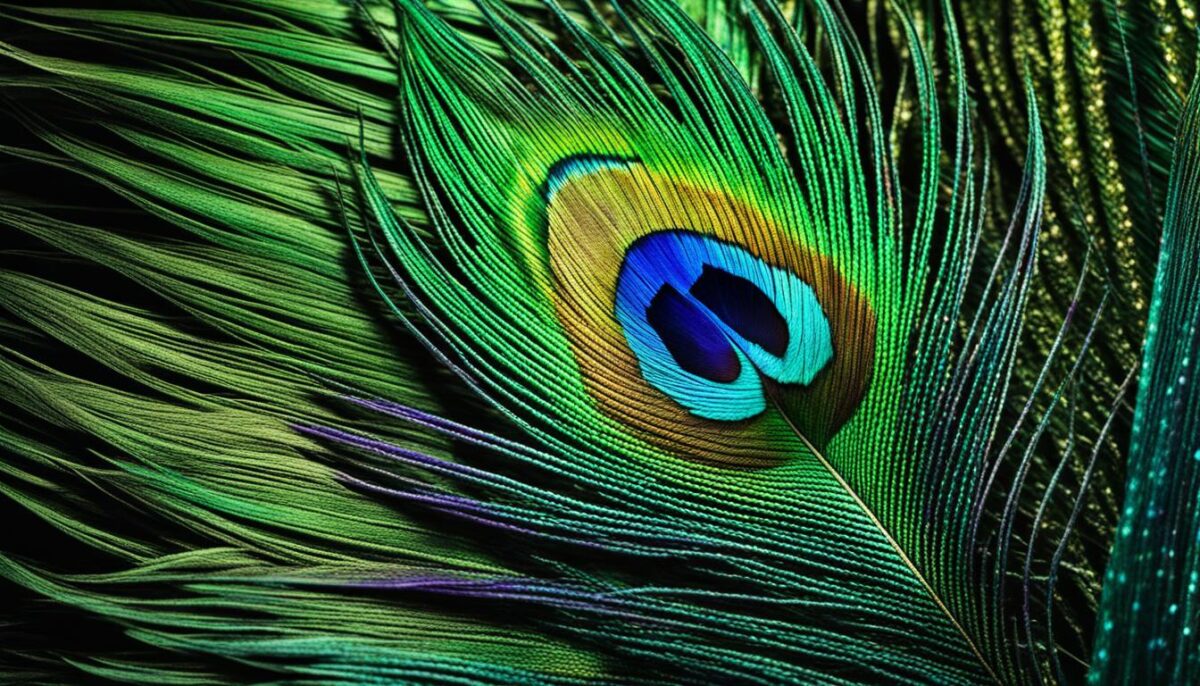
Peacock colors are a testament to the remarkable interplay between biology and physics, showcasing the beauty and complexity of nature’s palette. The optical physics behind peacock colors continues to inspire awe and curiosity, inviting us to unravel the mysteries of light and color in our natural world.
The Art and Science of Color Production
Peacock feathers are not only a marvel of nature but also a source of inspiration for scientists and engineers exploring the field of biomimicry. The structural colors found in peacock feathers have led to the development of artificial materials and optical technologies that mimic the vibrant hues and light manipulation abilities seen in these beautiful birds.
By studying the intricate nanostructures and the way light interacts with them, researchers have gained insights into how to create materials that can change color or reflect specific wavelengths of light. This knowledge has applications in various fields, including the development of color-changing chemical sensors, advanced display technologies, and innovative light manipulation techniques.
“The structural colors found in peacock feathers provide a blueprint for creating artificial materials with unique optical properties. These materials have the potential to revolutionize industries such as fashion, design, and even healthcare,” says Dr. Maria Rodriguez, a materials scientist at the University of Science and Technology.
One example is the development of photonic crystals, which are synthetic materials that mimic the structure of peacock feathers to create vivid and iridescent colors. These materials can be used in the production of color-changing textiles, cosmetics, and architectural coatings.
| Application | Artificial Material/Technology |
|---|---|
| Textiles | Photonic crystals for color-changing fabrics |
| Displays | Micro- and nanostructures for improved screen resolution and color reproduction |
| Sensors | Bio-inspired sensors for detecting chemical changes |
| Optics | Nanostructures for manipulating light at the subwavelength scale |
The art and science of peacock colors not only enhance our understanding of nature’s fascinating creations but also pave the way for innovative technologies that can transform industries across the board. By harnessing the optical brilliance of peacock feathers, scientists and engineers continue to push the boundaries of what is possible in the world of color production and light manipulation.
Unveiling the Beauty of Peacock Colors
The vibrant and diverse colors of peacock feathers have captivated humans for centuries. These colors have been admired for their beauty, leading to peacocks becoming symbols of divine beauty, love, paradise, and purity in various cultures. The intricate patterns, iridescent shine, and sheer brilliance of peacock feathers make them highly valued in art, fashion, and design. The unique colors of peacock feathers continue to fascinate and inspire creativity among artists, designers, and nature enthusiasts alike.
Peacock feathers are not just visually stunning; they also hold a deep symbolism. In many cultures, peacocks are seen as symbols of beauty, grace, and renewal. Their vibrant colors represent the interconnectedness of nature and the cycle of life. The aesthetic appreciation of peacock feathers goes beyond their visual appeal; it extends to the cultural significance associated with these magnificent birds.
“Peacock feathers are like a work of art created by nature itself,” says renowned artist Jane Johnson. “The vibrant colors and intricate designs are mesmerizing. As an artist, I find endless inspiration in the beauty of peacock feathers. The play of light on their feathers creates a sense of movement and depth, making them truly captivating.”
The allure of peacock feathers also extends to the fashion industry, where their vibrant colors and unique patterns are incorporated into clothing, accessories, and jewelry designs. Designers such as Alexander McQueen, Christian Dior, and Gucci have all drawn inspiration from the beauty of peacock feathers, creating stunning and iconic pieces that celebrate their captivating colors.
| Cultural Symbolism | Aesthetic Appreciation |
|---|---|
| Peacocks are seen as symbols of divine beauty, love, paradise, and purity in various cultures | Peacock feathers are admired for their intricate patterns, iridescent shine, and sheer brilliance |
| They represent interconnectedness of nature and the cycle of life | Artists find inspiration in the vibrant colors and play of light on peacock feathers |
| Their cultural significance goes beyond visual appeal | Peacock feathers are highly valued in art, fashion, and design |
Conclusion
The stunning array of peacock colors showcases the incredible diversity and beauty of nature’s palette. Peacocks are known for their vibrant and captivating feathers, which come in a wide range of shades. From the common blue and green peacock colors to the rare whites, reds, purples, and pinks, these birds display a remarkable spectrum of coloration.
Peacock colors are not only a result of pigmentation but also the unique structural arrangements of their feathers. The microscopic structures within the feathers interact with light in specific ways, resulting in the iridescent and dazzling colors observed. This combination of pigmentation and structural arrangements gives peacocks their distinct and mesmerizing appearance.
Understanding the science behind peacock colors not only enhances our appreciation of these magnificent birds but also enables advancements in optical technologies and biomimetic materials. Scientists and engineers are inspired by the structural colors found in peacock feathers to develop artificial materials and technologies that manipulate light and mimic the stunning color production of these birds.
The captivating peacock colors, with their vibrant hues and iridescent patterns, continue to fascinate and inspire awe. As symbols of nature’s beauty, peacocks remind us of the incredible diversity and wonder of the natural world’s color palette.
FAQ
How do peacocks get their different colors?
Peacock colors are a result of both pigmentation and the unique structure of their feathers. The pigmentation adds depth and richness to the colors, while the feather structures scatter and reflect light, creating iridescence and vibrant shades.
What are the most common peacock colors?
The most common peacock colors are blue and green. Blue peacocks have bold blue coloration on their heads and necks, while green peacocks have a green coloration on their heads and necks.
Are there any rare colors found in peacocks?
Yes, there are rare peacock colors such as white, red, purple, and pink. These colors can be the result of genetic mutations or unique variations in pigmentation.
How are peacock feathers able to reflect different colors?
The structures in peacock feathers, such as ridges, rods, and platelets, interact with light in specific ways, scattering and reflecting certain wavelengths more strongly than others. This creates the vibrant and iridescent colors observed in peacock feathers.
Do peacocks change their colors like chameleons?
No, peacocks do not change their colors like chameleons. The colors of peacock feathers are determined by genetics and feather structure, rather than active physiological changes.
What colors do peacock eggs have?
Peacock eggs typically have white or light brown coloration.
How long does it take for peacocks to reach sexual maturity?
Male peacocks reach sexual maturity around 2 years of age, while female peahens reach maturity around 3 years of age.
How many chicks do peacocks typically produce per year?
Peacocks can produce 4 to 7 chicks per year.
How many species of peacocks are there?
There are three main species of peacocks: Indian peacock, Congo peacock, and green peacock.
How are peacock colors created on a scientific level?
Peacock colors are the result of optical physics. The microscopic structures in the feathers interact with light, scattering and reflecting specific wavelengths to create the vibrant colors.
How have peacock colors inspired scientific advancements?
The understanding of peacock colors has led to research in developing artificial materials and optical technologies that mimic the unique color production. This research has potential applications in various fields, such as chemical sensors and display technologies.
What significance do peacock colors hold in art and culture?
Peacock colors have been highly admired for their beauty and have become symbols of divine beauty, love, paradise, and purity in various cultures. The intricate patterns and vibrant colors of peacock feathers continue to inspire creativity in art, fashion, and design.


